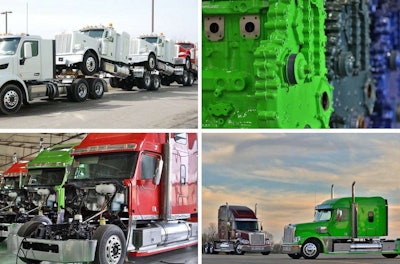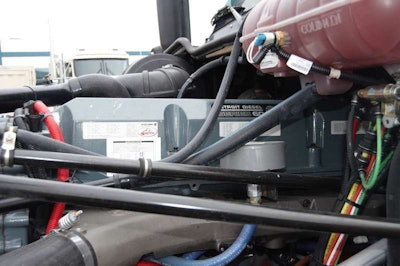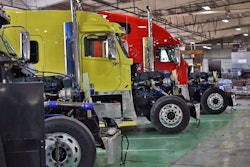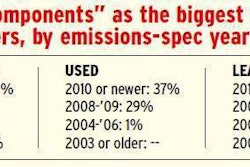 Glider kits in the midst of the assembly process at Fitzgerald Glider Kits’ Byrdstown, Tenn., plant. Today’s glider kits are taking off, offering the same amenities and similar resale value and warranties as dealer trucks. One of the biggest attractions lies under the hood: Pre-EGR Detroit 60 Series engines. Click here or the photo above to see a photo gallery of how glider kits come together at Fitzgerald’s plant.
Glider kits in the midst of the assembly process at Fitzgerald Glider Kits’ Byrdstown, Tenn., plant. Today’s glider kits are taking off, offering the same amenities and similar resale value and warranties as dealer trucks. One of the biggest attractions lies under the hood: Pre-EGR Detroit 60 Series engines. Click here or the photo above to see a photo gallery of how glider kits come together at Fitzgerald’s plant. Despite the industry’s lackluster truck sales since the recession, Cookeville, Tenn.-based Fitzgerald Glider Kits has seen sales double each year since 2010, and it expects the trend to continue in 2014.
Though Fitzgerald concentrates its builds and engine programming on fuel economy and maintenance ease, its sales point to a growing trend for its owner-operator customers: the desire to run a new truck powered by a pre-exhaust gas recirculation engine.
Also, gone are the concerns from 20 or 30 years ago about gliders’ quality and resale value, says Jay Burgess, a buyer for Insurance Auto Auction, a used truck reseller.
 HOW GLIDERS COME TO BE | Click here or the photo above to see a step-by-step photo gallery of how gliders come together at Fitzgerald’s plant. HOW GLIDERS COME TO BE | Click here or the photo above to see a step-by-step photo gallery of how gliders come together at Fitzgerald’s plant. |
Glider bodies, chassis, rear-ends and wiring are fully assembled and delivered to manufacturers such as Fitzgerald, the largest glider maker in the United States, and Ervin’s, the second-largest, which then install the engine and transmission. Builders like Fitzgerald and Ervin’s have helped spur demand for new and used gliders.
What’s the most popular glider equipment?
Fitzgerald stocks its own engines, obtained from truck teardowns or salvage companies, says Tommy Fitzgerald, owner and vice president. It remachines and rebuilds them with remanufactured components.
Fitzgerald uses only 2003 year-model or older 12.7-liter Detroit Series 60 engines that are torn down and rebuilt in-house. It couples them with remanufactured Eaton-Fuller transmissions purchased from Eaton.
Ervin’s buys Freightliner “powered gliders” with remanufactured Detroit engines, 2003 and older, already installed, says Ken Eggen, director of business development. The company also uses reman Eaton-Fuller transmissions from the factory.
Why buy a glider?
Three key benefits of buying a glider are lower upfront cost and the potential for both lower maintenance costs and improved aftermarket value, says Eggen.
Ervin’s sells Freightliner Coronado and Columbia models, and they cost about 10 to 15 percent cheaper than a similarly spec’d factory truck.
 Gliders offer simple way to natural gas use: Glider kits can give owner-operators an easier, cheaper way to delve into natural gas power than buying a new dedicated truck off the lot, and for about $50,000 cheaper than a new natural gas truck off the lot. Click here or the photo above to read more on dual-fuel natural gas gliders. Gliders offer simple way to natural gas use: Glider kits can give owner-operators an easier, cheaper way to delve into natural gas power than buying a new dedicated truck off the lot, and for about $50,000 cheaper than a new natural gas truck off the lot. Click here or the photo above to read more on dual-fuel natural gas gliders. |
A Coronado from Fitzgerald starts at about $109,900, and its Peterbilt 389 starts at $126,500. Compared to a similarly spec’d factory truck, that’s about 25 percent cheaper, says Tommy Fitzgerald.
Initial equipment costs aside, Fitzgerald concentrates its builds on lower cost of ownership through fuel economy and lower cost of maintenance.
“We set the engine up to where it can be more efficient,” says Tommy Fitzgerald. Fuel economy benefits, he says, are achieved through special programming of the engine’s electronic control module and from the external and internal parts used in the engine rebuilding process.
Fitzgerald says that based on customer feedback from real-world testing, the company pegs the mpg of its kits at 7 or higher.
The company also has its own routing placement for hoses and wiring designed to make maintenance work easier. “Through fuel mileage and maintenance costs, it has a lower cost of operation year by year,” Fitzgerald says.
Ervin’s tailors its sales to “high-idle” applications such as mining, logging, construction, bulk transport and oil field hauling. Diesel particulate filters and EGR engines don’t fit these applications as well as a non-EGR engine, Eggen says.
Long-haul applications may not see the same benefits as the higher-idle applications because DPFs on post-2007 trucks are able to regenerate more effectively, he says.
Perhaps of most interest to many buyers, gliders employ the simpler, proven technology of pre-EGR engines, says Tony Mohler, used truck manager for Nashville Rush Truck Center. “There’s less that can go wrong as far as not having the aftertreatment systems,” Mohler says. “And styling-wise, a guy can get a brand new piece of equipment and theoretically save some money.”
How strong is resale value?
IAA’s Burgess sees glider kits with pre-2003 model engines getting as much as $10,000 more in resale than comparable factory trucks “because they’ve got pre-emissions engines. People are willing to pay more money for that.”
Burgess scours the Southeast to find trucks for auction, and one of his main jobs is to tell customers what their trucks are worth. He connects about 250 truck sellers a week to auctions, he says.
Auctioned gliders with reman engines bring about 7 to 9 percent more over comparable trucks, Burgess says. “The trucks are of just as good quality as any new truck that goes down the assembly line,” he says.
Gliders used to carry a stigma, says Robert Fitzgerald, co-owner and president at Fitzgerald. “People always believed gliders on the resale side are worth less,” he says. “But what we’ve found now that we’ve developed a market is that we can actually get more on the backside.”
Ervin’s Eggen says owning a glider made with original manufacturer’s parts “takes away fear of sliding in resale value.” Like Fitzgerald, Eggen says he’s seen Ervin’s trucks hold their value better in the aftermarket than factory trucks.
How do warranties work?
The glider shell – cab, chassis and wiring — comes with a 1-year, 100,000-mile factory warranty, says Tommy Fitzgerald. Peterbilt and Kenworth also have a standard 5-year, 750,000-mile warranty on the rears, and Freightliner has a standard 3-year, 300,000-mile warranty on the rears, he says.
Eaton-Fuller reman transmissions come with a 3-year, unlimited mileage warranty. The reman Detroit engines come with a 3-year, 300,000-mile warranty.
The engine warranty also can be done through Fitzgerald, Tommy says. The company also offers a 5-year, 500,000-mile upgradable nationwide warranty that’s handled in-house.
The warranties are good at any Freightliner or Detroit authorized repair shop, and all the warranty information is already in the system, Eggen says.
What are potential hang-ups?
• As for resale value, aftermarket sentiment varies, says Mohler. Many dealers won’t buy or trade gliders because dealers can’t be sure of the origins of the truck’s componentry, nor can they apply aftermarket warranties to them as easily. Reputable manufacturers like Fitzgerald’s and Ervin’s can mitigate these concerns, though.
• California requires a particulate filter in engines older than 2006. Complying with this to enable running in California would mitigate some of the benefits sought in the first place. Because California emissions regulations sometimes have been adopted in other states, avoiding business in California might not be a long-term solution.
• Some gliders may not have access to the service network that new trucks would, depending on the components used in the build, Mohler says.









